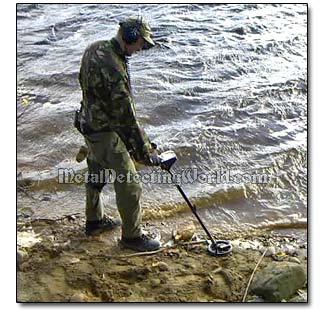Types of Metal Detecting Activities, page 17:
DRY SAND BEACH HUNTING
(CONTINUED from previous page)
Grid Search Patterns for Dry and Wet Sand Beach Hunting
During beach hunting, if you find a productive spot - a "pocket" of coins or jewelry, it may be worthwhile to grid the area to make sure you cover every square inch of this productive spot.
To do gridding, one should walk a straight line parallel to the surf. Once through the area, one steps a foot or two over and walks back. The search coil should overlap the last track (read more on search coil discipline here).
To see exactly what area has been searched and keep inside predetermined boundaries (real or imaginary), one can simply mark the grid by dragging the beach scoop in the sand.
Another situation may occur when a beach hunter discovers not just a "pocket" of gold and silver jewelry, but a productive strip that runs parallel to the surf line. In this case, it is wise to walk straight lines through the entire strip that might extend to a dozen of yards or more.
To locate productive coin or jewelry pockets on beach, S-shaped or Zigzag gridding patterns are used; the width of the area covered should extend from the surf line to the high-tide mark. You should not worry about missing a few valuables. Even if you miss a few gold items, you will find other ones during your next visit because every time you come to the beach, it is "reloaded." The beach contains plenty of treasures, more than you can imagine, and enough for all!
How Jewelry Gets Lost on Dry Sand Beach
Loosing jewelry on dry sand beach is caused by the following actions:
1) Applying slippery sunscreen or suntan oils to hands makes fingers slippery and allows the rings to slide off easily.

2) Participation in various beach sport activities and engagement in horseplay makes people lose a large amount of jewelry.
The clasps on necklaces, bracelets, anklets and chains are too weak to withstand ball hits, contacts with sand, and grabbing of bearer's neck, arms and legs by other participants.
Playing the ball particularly flings the rings off the fingers. When valuables drop into the sand, they quickly sink out of sight and, in a moment, are trodden deeper by players.
3) Shaking the beach blanket or towel causes accidental discarding of jewelry which was initially placed there and then forgotten. Also the jewelry often is shaken off the blanket during the emergency departure caused by sudden storm, rain, gale, etc. In this case, jewelry is usually recovered right away, but anything small has a tendency to disappear fast in the sand when dropped, and is hard to see, especially in darkness.
Freshwater Dry Beach Detecting

Freshwater dry beach hunting refers to metal detecting on dry beaches of the freshwater lakes and on sandy or free of vegetation riverbanks. This type of beach hunting results in recovering oldest coins, jewelry and relics because historically the rivers and river bodies were the earliest means of transportation and commerce.
The most productive spots include old ferry landings, beaches, popular swimming holes, merchant boat landings, places of historical battles, coastal shipwrecks, etc.
Freshwater dry beach hunting does not require a beach/surf/underwater metal detector and can be done with a regular land metal detector of any type. You can use the same settings on your detector that you normally use at the land hunt sites.
If there is a tidal activity on the river, you may use it to your advantage by venturing onto the wet sand (see more details in the Freshwater Wet Beach Hunting section on page 9) since no additional equipment or accessories will be required. You just need to study the tide charts that are regularly published in a local newspaper. Knowing exact hours of high tides will help you get the most out of your river metal detecting.